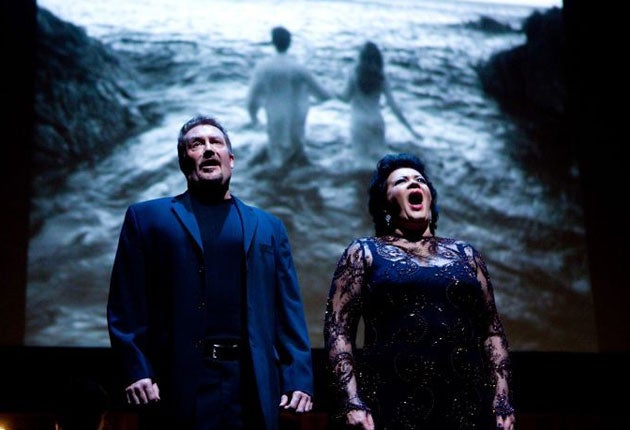Tristan und Isolde, Symphony Hall, Birmingham
Lovers find new depths of passion

Good for Symphony Hall: it boldly took on this spectacular semi-staged presentation of Wagner's Tristan und Isolde, which – with its video art on a massive overhead screen and its choreographed, spatial musical effects – presented immense technical challenges. The Philharmonia Orchestra, under its principal conductor Esa-Pekka Salonen, realised Wagner's music-drama in a way that cast unexpected new light on an old story. Some of it was brilliantly illuminated by the imagery of the Californian artist Bill Viola, created in collaboration with the director Peter Sellars, flooding the mind and eye for almost the entire four-plus-hour duration of the opera.
Not a literal representation, the visuals included some billowing seascapes that passed for the Cornish coast towards which Tristan and Isolde are sailing in the first act. But the primary impression was of a man and a woman undergoing ritualistic purification, their gradual progress towards the camera, stripping away of clothes, washing and immersion in water adjusted to coincide in time with the live performance. The riddance of sexual longing that characterises Tristan was conveyed in arty shots of bodies, faces, eyes and hair and of fire and bubbling water while, later, endless candles were lit, torches burned, and the sun rose. At the end, in the least successful image, the body of the video character representing Tristan simply floated upwards and deliquesced.
In his so-called programme "synopsis", Sellars declares that King Marke, Tristan's uncle, was also the young knight's first lover. In a production in which the first-rate cast seems to take vigorous flight in its non-virtual existence, there is no physical contact between Tristan and Isolde, even after they have drunk the love potion. But having Marke embrace Tristan in a tight hug not only suggests that Sellars might prefer the work renamed Tristan und Marke but traduces the importance of the renunciation of sex in Tristan.
Musically, this Tristan was a profound and moving experience. Violeta Urmana, reprising the role she took in the recent Proms' airing of the second act, demonstrated both a reach and a beauty that sustained her almost to the performance's slightly underwhelming close. Gary Lehman was a vital, impassioned Tristan and Matthew Best an eloquent, authoritative Marke, painfully anguished in his second-act monologue. Anne Sofie von Otter opted to be a surprisingly cool Brangäne while Jukka Rasilainen's robust Kurwenal was touchingly unmannered.
Once over the hurdle of what to focus on – the montage of imagery, the surtitles (situated impossibly high in the third act), the magnificent singers positioned around the hall, the doughty instrumentalists placed centre-stage – what really gripped one's attention was the ebb and flow of Salonen's conducting and the insightfulness of the orchestral playing. In the acclaimed acoustic of Symphony Hall, the surround-sound effect – enhancing lusty choral-singing and insightful orchestral playing – represented an electrifying aspect of an unforgettable evening.
Join our commenting forum
Join thought-provoking conversations, follow other Independent readers and see their replies
Comments